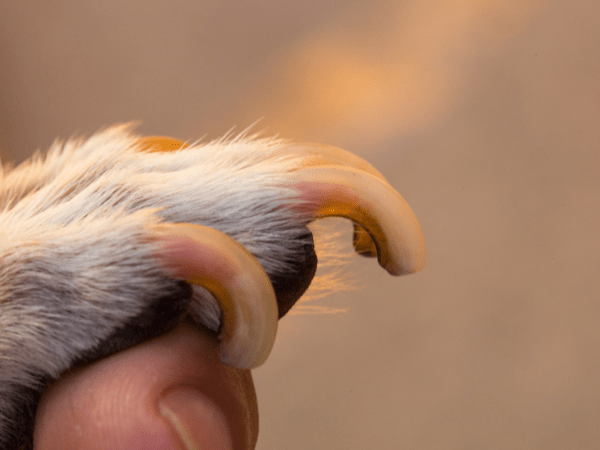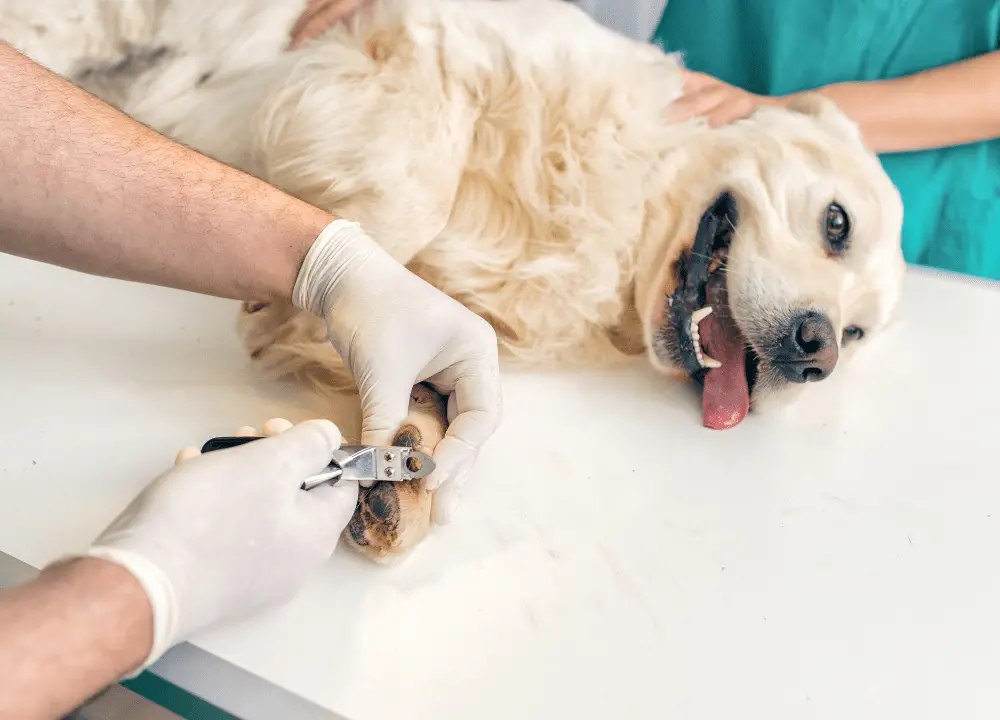If your dog’s nail is bent at 90 degrees, seek immediate veterinary attention to prevent infection and ensure proper healing. Avoid attempting to straighten or clip the nail yourself to avoid additional injury.
Dealing with a dog’s nail injury can be both alarming for the pet owner and painful for the animal. A nail bent at a severe angle such as 90 degrees often warrants urgent care to address potential complications, including bleeding, infection, and long-term damage to the nail bed.
As a pet owner, recognizing the severity of the situation is crucial, and prompt action is needed. Remaining calm and providing comfort to your dog during this stressful time will help reduce their anxiety and make it easier for a veterinarian to administer the necessary treatment. Ensuring your pet’s physical health is a priority, and proper nail care is an essential aspect of routine dog maintenance. Addressing these injuries promptly can help your dog remain active and pain-free.
Assessing The Situation
You just noticed your furry friend’s nail bent at a worrying angle. Don’t panic—your next steps are crucial to your dog’s comfort and health. Before taking any action, assess the situation carefully.
Checking For Signs Of Distress
First, observe your dog closely. Look for any signs of pain or distress. Dogs communicate discomfort in various ways. Here are things to watch for:
- Limping or favoring one paw over others
- Whining or whimpering, especially when the paw is touched
- Continuous licking at the affected nail or paw
- Avoidance behavior, such as hiding or avoiding contact
Assessing The Severity Of The Bend
Closely examine the bent nail. But remember not to touch it yet. Your goal is to determine how severe the bend is without causing more pain. Use these steps to assess:
- Without touching, look for any swelling or redness around the nail.
- Check the angle of the bend. A slight bend may require less urgency than a complete 90-degree angle.
- Notice if there is any bleeding or discharge. These are immediate red flags.
Determining the bend’s severity will inform your next steps. If the nail is severely bent or there are signs of infection, consider contacting your vet right away.

Immediate Care
The moment you notice your dog’s nail bent at a right angle, stay calm. Your furry friend needs your help. Proper immediate care will prevent worse pain or infection. Let’s guide through the first steps you need to take:
Muzzle Your Dog
Even the gentlest dog might snap when hurt. Before doing anything, place a muzzle on your dog. If you don’t have one, use a soft cloth or a piece of gauze. Tie it around the snout safely. This protects both of you during care. Remember, it’s for a short time only.
Apply Pressure To Stop Bleeding
Injured nails often bleed. Don’t worry, this is normal. Act quickly to stop the blood flow. You can use a clean cloth or gauze for this. Press gently against the nail. Hold the pressure for a few minutes until bleeding lessens. After, apply a bandage. But, keep it not too tight. Watch the toe for swelling or more pain. If bleeding continues, you need a vet right away.
- Stay calm and act quickly to comfort your pet and tackle the issue.
- Secure a muzzle on your dog to ensure safety for both.
- Press with a clean cloth on the nail to manage bleeding.
- Seek professional help if bleeding won’t stop or seems severe.
Seeking Veterinary Assistance
Seeking Veterinary Assistance for your dog is crucial when you notice a nail bent at a 90-degree angle. This can indicate a serious injury. Immediate care from a professional is essential to prevent infection and alleviate pain. In the following sections, learn how to effectively communicate with your veterinarian and prepare your dog for safe transport to the clinic.
Contacting Your Veterinarian
Once you spot the bent nail, call your vet right away. Describe the injury briefly and clearly. This helps the vet understand the urgency. Remember to provide your contact information accurately. The vet might give you some quick first-aid tips over the phone. Follow these carefully to ensure your dog’s comfort and safety.
Preparing Your Dog For Transport
Comfort is key when moving your pet. A bent nail is painful and stressful for your dog. Try to keep your dog calm. Use a gentle voice and slow movements.
- Secure your pet in a carrier or use a harness for larger dogs.
- Place a soft blanket inside to cushion the injured paw.
- Avoid touching the injured area to prevent further pain.
Make the ride to the vet as smooth as possible. Swift but gentle handling can lessen your dog’s anxiety.

Avoiding Further Injury
Suffering from a bent nail can be a painful ordeal for your canine companion. Preventing further injury is critical to ensure a swift recovery. Below are steps to keep your dog safe and help its nail heal properly.
Restricting Movement
- Keep your dog in a confined area to limit its movement. Choose a space small enough to prevent running or jumping.
- Use a comfortable dog crate or block off a section of your home.
- Consider doggy gates to restrict access to stairs or slippery floors that could cause further harm.
- Always supervise your pet if it needs to walk, especially when going outside for bathroom breaks.
Providing Comfort And Support
- Create a soft and cozy resting area using blankets or a dog bed. This cushions the sore nail.
- Offer your dog its favorite toy to keep it calm and stationary.
- Consult your vet for pain management options. They may recommend safe pain relief medication.
- Monitor the nail for signs of infection, such as swelling, redness, or discharge.
- Change bandages if used, as instructed by a vet, to keep the nail clean and protected.
Post-treatment Care
After your dog’s nail injury is treated, the post-treatment phase is crucial. Good care ensures a quick and full recovery. Let’s discuss important steps for post-treatment care.
Following Veterinary Advice
Once your vet has treated the bent nail, following their guidance is key. Your vet may recommend:
- Restricting movement to prevent further injury.
- Medication administration, such as pain relievers or antibiotics.
- Bandage changes to keep the area clean.
- Signs that the wound may be worsening.
Adhere to your vet’s instructions for a speedy recovery. Do not skip prescribed medication doses. Ensure your pet gets plenty of rest.
Monitoring Healing Process
Regularly check the affected area for signs of healing or infection. Look out for:
- Redness or swelling, which may indicate infection.
- Discharge or bad smell from the wound.
- Changes in pet’s behavior, like increased licking or biting at the nail.
- Keeping the nail dry and clean to avoid complications.
If any of these signs appear or if the nail doesn’t seem to be healing, contact your vet promptly. Regular follow-up appointments are also essential to monitor progress.
| What to Monitor | Signs of Concern | Action to Take |
|---|---|---|
| Appearance | Redness, swelling | Contact vet |
| Discharge | Any unusual discharge | Seek advice |
| Behavior | Incessant licking, biting | Observe and inform vet |
Mind these crucial steps for post-treatment care and your loyal friend will be on the path to recovery!
Preventive Measures
Keeping your dog’s nails healthy is key to preventing painful issues like a nail bending at a 90-degree angle. These preventive measures will save your furry friend from discomfort and possible injury. By following simple steps, you can ensure their paws stay in top shape.
Regular Nail Trimming
Regular nail trimming helps to avoid overgrowth and the risks of your dog’s nails getting bent or broken. Not sure how often to trim? Check your dog’s nails monthly.
- Maintain a trimming schedule.
- Use the right tools like a dog nail clipper or grinder.
- Keep treats on hand to reward your dog after trimming.
- Trim nails after a bath when they are softer.
Protecting Nails During Activities
Active dogs need extra care to protect their nails during outdoor play. Keep them on soft grass or soil and away from hard surfaces that can cause wear or damage.
- Choose play areas that are nail-friendly.
- Provide booties for rough terrains.
- Avoid prolonged activities on pavement or asphalt.
I recommend reading: Can Dogs Have Prader-Willi Syndrome?
Frequently Asked Questions
How Do You Treat A Bent Dog’s Nail?
To treat a bent dog nail, first calm your pet and stop any bleeding with styptic powder. Consult your vet for advice, as they may recommend trimming or special care. Prevent infection by keeping the area clean and watch for signs of pain or worsening condition.
Can A Dog’s Broken Nail Heal On Its Own?
A dog’s broken nail can heal on its own if it is a minor break. It is essential to keep the area clean to prevent infection. For severe breaks, consult a vet for proper care.
Is A Torn Dog Nail An Emergency?
A torn dog nail can be an emergency, as it may cause pain or lead to infection. Seek a vet’s attention promptly for proper care and treatment.
What Happens When A Dogs Nail Is Bent?
If a dog’s nail is bent, it can cause pain, swelling, and possible infection. Immediate care from a vet is recommended to prevent further injury or complications.
Conclusion
Dealing with a dog’s injured nail can be distressing for both pet and owner. Prompt attention is crucial. Remember to stay calm, assess the situation, and consult your vet for advice. By taking proper care, you can ensure your furry friend’s paw heals quickly and they’re back to their playful self in no time.


